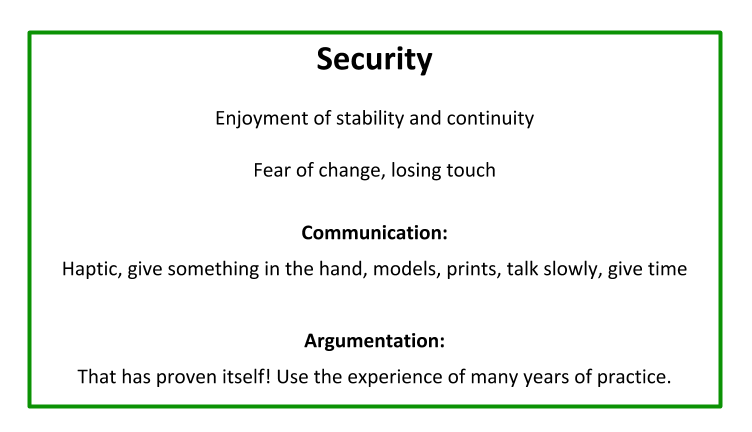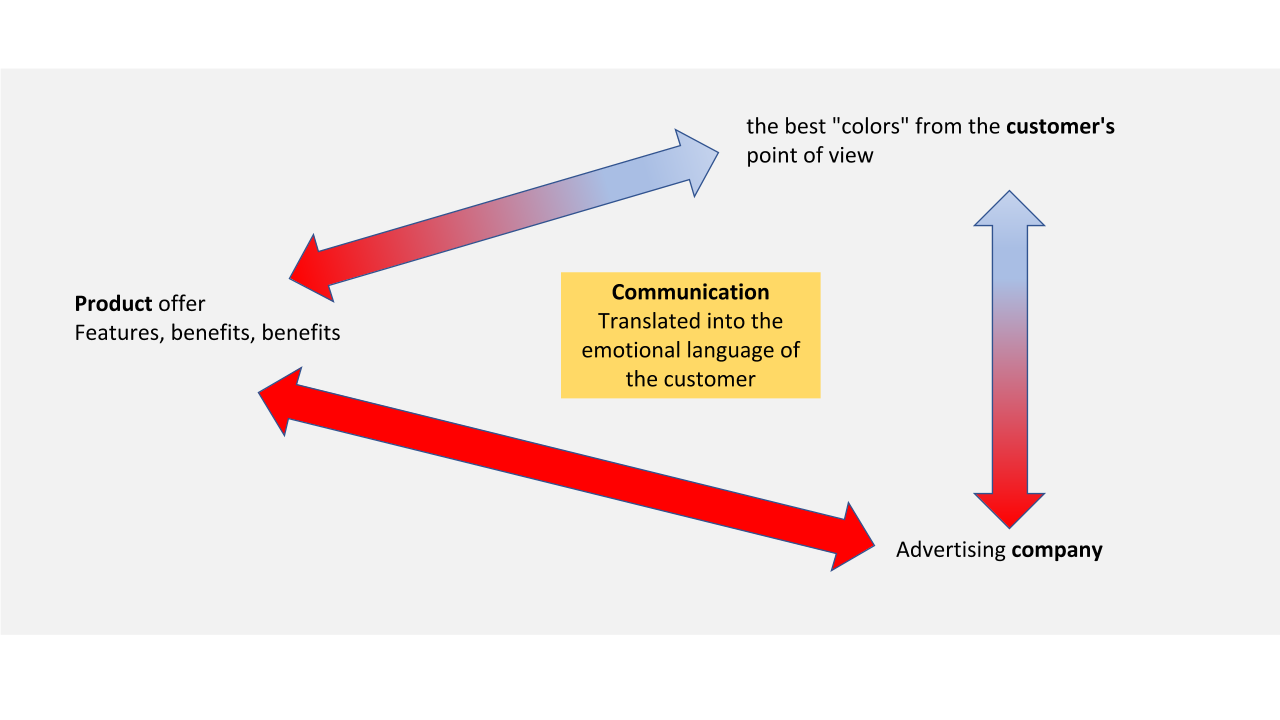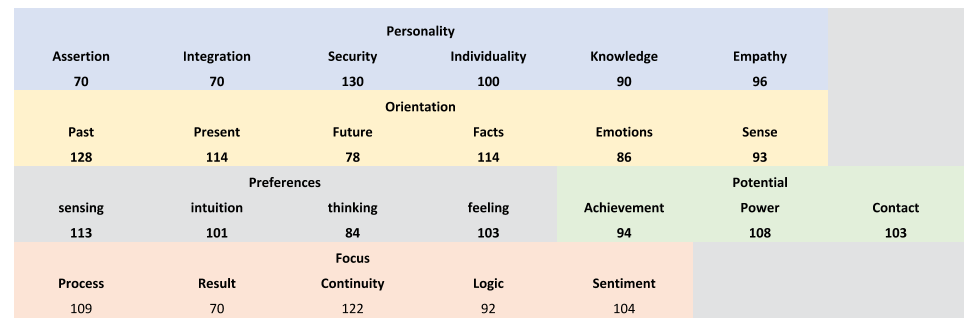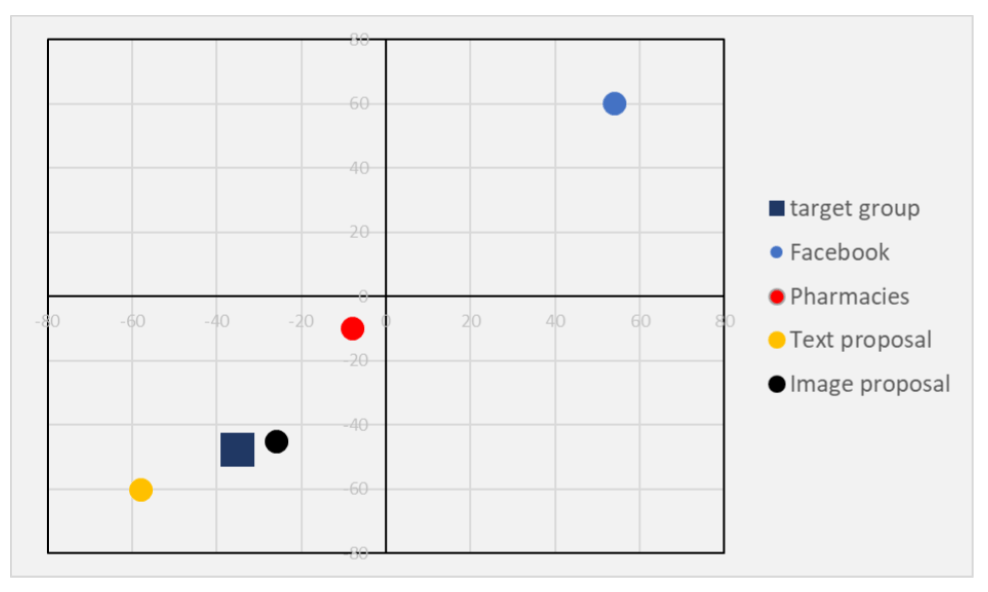Emotional Marketing
Customers are people. They have different needs, set individual priorities and use different sensory channels for their decisions. Doctors, bricklayers, electrical engineers, lawyers or employees have different amounts of money and follow different professional fashions. But they always agree on one thing: to live well you need security, contact, individuality, development opportunities, empathy and knowledge.
To tell a customer who is focused on security that his world will change with certain products or services causes anxiety. Positive hits are not to be expected in such a way. There are quite clear operating instructions for every type of customer:

Personality determines how much of each need must be met: There are security types, contact people, individualists, adventurers, sentimentalists and philosophers - and their hybrid forms. These people react in different, sometimes contradictory ways. What happens if an adventurer is offered a security concept, or if an individualist is wooed with the argument that he finally belongs with the product? One sows motives and reaps rejection - at least distrust.
The task of IPM systematics is to enable congruent communication. For this purpose, the address or effect of all elements is coordinated in colour.

Personality of the target groups
The IPM system can be integrated into market research tools. However, a simple, effective and cost-effective alternative is the text analysis of IPM. Copy typical statements of people to be reached into a text field. Here is an example of a rheumatism patient:
I suffer from bad feelings of heat in the joints and cool them with water or cool packs. That helps, but does not work the whole day... What could help me, do you have tips or medications that can help? I am mainly concerned with the hip joints, wrists, ankles and knee joints...
For this text and in total as the mean value of all texts of potential customers, 24 values are determined (IPM uses a scale from 0 to 200 with a mean value of 100 for all test persons in this category):

Personality of Communication
This method can also be used to compare different communication media with each other. In the next step, the users of the system evaluate the "emotional classification" of texts and visualizations. Here, for example, is a planned ad version - based on the basic needs:
Image display: individuals, separated, detailed, concrete, bright, with text
| Enforcement | Association | Security | Individuality |
|---|---|---|---|
| 80 | 80 | 80 | 120 |
Image content: doctor, documentation, stethoscope, ballpoint pen, patient, back, head
| Enforcement | Association | Security | Individuality |
|---|---|---|---|
| 80 | 91 | 120 | 84 |
Image associations: counselling, professional, trust, answers, hope
| Enforcement | Association | Security | Individuality |
|---|---|---|---|
| 80 | 108 | 80 | 120 |
Overall impression of the visualization
| Enforcement | Association | Security | Individuality |
|---|---|---|---|
| 70 | 82 | 99 | 130 |
This visualization is attractive for people with a high need for individuality (values > 110), it is rather neutral on security types (values 90 to 110).
The analysis of different textual statements can be done playfully with the system. Simply enter different formulations into the text field and compare the results with the target values.
Painlessness and joy of movement are possible
| Enforcement | Actual | 120 | Target | 70 |
| Association | Actual | 80 | Target | 70 |
| Security | Actual | 80 | Target | 130 |
| Individuality | Actual | 80 | Target | 100 |
Long lasting pain control
| Enforcement | Actual | 80 | Target | 70 |
| Association | Actual | 80 | Target | 70 |
| Security | Actual | 120 | Target | 130 |
| Individuality | Actual | 80 | Target | 100 |
Pain-free for rheumatism - the natural alternative
| Enforcement | Actual | 80 | Target | 70 |
| Association | Actual | 80 | Target | 70 |
| Security | Actual | 120 | Target | 130 |
| Individuality | Actual | 120 | Target | 100 |
Compare the alternatives with each other
After the image and text ideas have been brought closer to the target group, the media, distribution channels etc. can also be included in a matrix.

Matching emotional orientations are shown by the proximity of the dots in the graphic. In this example, Facebook as a communication medium could be expected to show large scattering losses.
Product Management
Depending on the purpose and the desired level of detail, all 24 characteristic values can be reconciled with each other. Sometimes experience plays a role in competition with other product providers, sometimes performance aspects or rationality are more important.
When it comes to defining new target groups for new offers, it makes sense to draw up a catalogue of criteria. How does the potential customer think, feel and decide?
| Achievement | Power | Contact |
|---|---|---|
| A good life is when we do something valuable. | A good life is when we act freely and on our own responsibility. | A good life is when we are close to each other and understand each other. |
| Self assertion | Integration | Security | Individuality |
|---|---|---|---|
| Life needs change, to develop, to progress and to assert one's wishes | Life needs the common ground of being well integrated, adapting and communicating with each other. | Life needs continuity, to be safe, to avoid danger and to stay healthy in the long term. | Life needs independence to be special and to be recognized as an individual. |
| Cognition | Empathy | Past | Present | Future |
|---|---|---|---|---|
| Without knowledge we do not know where we come from, where we are and which ways we can go. | Without empathy we know neither the emotional causes nor the possible consequences of our actions. | Without past we have no experience and can not judge the present. | Without the attentive perception of the here and now, we know no way into the future. | Without a future, our needs end immediately, because there are no desires, hopes and goals. |
| Facts | Emotions | Sense |
|---|---|---|
| What are the concrete, factual or physical consequences of a possible decision? | What feelings arise with me and my neighbor when I decide one way or the other? | What is a sensible choice when it comes to spiritual or higher values, ideals and goals? |
| Sensing | Intuition | Thinking | Feelings |
|---|---|---|---|
| Reality is conveyed by seeing, hearing, feeling, smelling and tasting quite concretely, realistically and in detail. | The reality is complex and we feel the fluid, holistic connections in a rather abstract way. | The truth is the rational, logical result of a mental, critical analysis of the context. | Unconscious perceptions and experiences give us a sense of what is wrong or right. |
| Continuity | Logic | Sentiment | Process | Result |
|---|---|---|---|---|
| We want to keep all the good and important even after a decision. | We want to think through the possible consequences according to the cause-and-effect principle. | We want to use our spontaneous ideas (gut feeling) as a reliable guidepost. | We want to have a good perception of how things are going. | We want to keep an eye on the goal and not let ourselves be distracted by occasional glitches. |
The future of personality orientation: from the conception of offers to the definition of target markets and the decision for the right market mediators, marketing controls which customer types are to be won and how. IPM supports this with tools and know-how transfer.